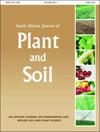A reflection on tick control and the potential role of botanical products in integrated management practices
IF 0.7
Q3 AGRONOMY
引用次数: 0
Abstract
Tick infestations and tick-borne diseases continue to be the leading causes of loss in livestock and revenue, particularly in developing countries, despite the prevalent use of synthetic acaricides. Research on plants as alternative sources of anti-arthropod agents has received attention from many researchers in the recent past. This interest is mainly motivated by the compelling need to move away from over-reliance on anti-arthropod synthetic chemicals, which have harmful effects on the environment and livestock. While many plants have been shown to possess anti-tick properties, such studies are in the main laboratory-based and thus their effects cannot be accounted for in the natural environments. Furthermore, knowledge on the mechanisms by which plant extracts impact ticks is sparse and not coordinated for ease of reference. The literature explored in this study was collected from indices included in the University of South Africa (UNISA) library database following keyword searches on plant extracts used as tick control methods and reviews. This article provides a consolidation of literature on the anti-tick properties of plant-based material and their prospects for being integrated with current tick control methods.蜱虫控制及植物产品在综合管理实践中的潜在作用的思考
尽管普遍使用合成杀螨剂,但蜱虫侵扰和蜱传疾病仍然是牲畜和收入损失的主要原因,特别是在发展中国家。近年来,植物作为抗节肢动物药物的替代来源的研究受到了许多研究者的关注。引起这种兴趣的主要原因是迫切需要摆脱对抗节肢动物合成化学品的过度依赖,这种化学品对环境和牲畜有有害影响。虽然许多植物已被证明具有抗蜱虫的特性,但这些研究主要是在实验室基础上进行的,因此它们的效果无法在自然环境中得到解释。此外,关于植物提取物影响蜱虫的机制的知识很少,而且为了便于参考而没有协调。本研究的文献收集自南非大学(UNISA)图书馆数据库的索引,检索了用于蜱虫控制方法的植物提取物的关键词并进行了综述。本文对植物基材料的防蜱特性及其与当前蜱虫防治方法相结合的前景进行了综述。
本文章由计算机程序翻译,如有差异,请以英文原文为准。
求助全文
约1分钟内获得全文
求助全文
来源期刊

South African Journal of Plant and Soil
Agricultural and Biological Sciences-Plant Science
CiteScore
1.90
自引率
11.10%
发文量
32
期刊介绍:
The Journal has a proud history of publishing quality papers in the fields of applied plant and soil sciences and has, since its inception, recorded a vast body of scientific information with particular reference to South Africa.
 求助内容:
求助内容: 应助结果提醒方式:
应助结果提醒方式:


